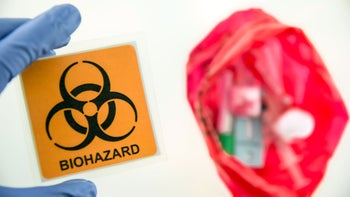
Testosterone Replacement Therapy (TRT): Side Effects, Risks, and Benefits
Key takeaways:
Testosterone is an important hormone for many functions in your body, such as muscle growth and making red blood cells.
Testosterone replacement therapy (TRT) helps raise testosterone levels in your body. And there are many different forms of TRT available, such as injections and gels.
Each form of TRT has its own side effects and risks to be aware of. But all of them can increase the risk of heart-related health problems. They’re also controlled substances that have a risk of dependence and misuse.
Table of contents

You’ve probably heard of testosterone, and you may know that it’s important for growing muscles and building strength. But did you know it’s vital for many other functions in your body as well? It’s a hormone that also helps maintain bone mass, distribute fat cells, and regulate sex drive and sperm production in men.
Factors such as age, health status, and sex can all affect your natural ability to make testosterone. Fortunately, if you need it, there are plenty of medications available to help improve your testosterone levels. The best medication choice for you ultimately boils down to your situation, but each one is a possible option to help you meet your health goals.
Here, we’ll talk about testosterone replacement therapy. We’ll also cover some things to watch out for and why one form of testosterone may be better for you than another.
What is testosterone replacement therapy (TRT)?
Testosterone replacement therapy (TRT) is used to balance or boost the amount of testosterone in your body. As men get older, their ability to make testosterone can go down. Certain health conditions may be tied to low testosterone production, including conditions such as autoimmune disorders, HIV, and diabetes.
If you're experiencing symptoms such as hair loss, irritability, or erectile dysfunction, a healthcare professional (HCP) may want to measure the amount of testosterone in your blood. If your levels are low, they may recommend trying TRT.
How to get TRT
TRT refers to a group of prescription testosterone medications. A licensed HCP can prescribe TRT to you.
Read more like this
Explore these related articles, suggested for readers like you.
Testosterone is a controlled substance, though. This means there are strict laws on how you can get it. By law, an in-person exam is required before a controlled substance can be prescribed for the first time. This law was temporarily relaxed during the COVID-19 pandemic, but in-person exams will be required again starting in 2025.
You may be able to get TRT refills without an in-person exam. But this will depend on your HCP’s directions.
Remember: You’ll need a blood draw to know if your testosterone levels are low. This can be done at a medical office or a laboratory diagnostic center.
Can you get TRT online?
No, you can’t get TRT online. However, if you have a prescription, you may be able to get it through a licensed mail-order pharmacy.
Keep in mind that laws for mailing controlled substances may vary by state. And different pharmacies may have their own rules about mailing controlled substances, too.
TRT treatment options
Testosterone comes in many forms. It’s important to be aware of the different types to better understand why you and your HCP may choose one over another.
Block quote
Keep in mind: There isn’t one “best” type of TRT. The most optimal choice will depend on your medical background, personal preferences, and financial picture. Side effects can also make a difference.
Testosterone injections
Testosterone shots, also known as testosterone injections, were one of the first forms of TRT to be approved for use. They’re still commonly used today.
Testosterone can be injected into your muscle or under your skin. It may be injected by an HCP, or you may be able to inject it yourself at home.
Injectable testosterone medications include:
Depo-Testosterone (testosterone cypionate)
Aveed (testosterone undecanoate)
Xyosted (testosterone enanthate), which is available as an easier-to-use autoinjector, but tends to be prescribed less frequently
How often you’ll receive an injection depends on the specific product. That’s because each one is formulated to remain in your body for a different amount of time. For example, after the first two doses of Aveed, you only need injections every 10 weeks. By comparison, Xyosted is usually injected once weekly.
Testosterone gels
Testosterone gels are applied directly to your skin and are absorbed into your body. They each contain different amounts of testosterone with specific instructions for use. Brand-name forms of testosterone gel include:
Fortesta
Testim
Vogelxo
After applying a gel, make sure to wash your hands thoroughly. It’s also important to avoid skin contact with others where it was applied. This helps prevent it from transferring to others or getting in your eyes, mouth, or nose.
Implanted pellets
Testosterone can also be implanted under your skin in the form of a pellet. This version of testosterone is called Testopel. It slowly releases testosterone into your body over time.
Testopel is a long-acting implant that can last up to 3 to 6 months. This is a convenient option if you don’t want to think about taking or using testosterone frequently. However, each pellet needs to be injected and removed by a HCP, so each dose requires a clinic visit.
Nasal gel
Testosterone is also available as a nasal gel called Natesto. This method involves using an applicator to pump the medication into each nostril. It’s absorbed by your body quickly, but it needs to be applied 3 times a day.
Oral pills
Oral forms of testosterone aren’t quite as common as the other forms. That’s because they’ve been linked with possible liver harm.
Still, Jatenzo (testosterone undecanoate) is available as a FDA-approved oral testosterone medication. It’s an option for men with low testosterone due to genetic disorders or cancer. Other testosterone pills include Methitest (methyltestosterone), Kyzatrex (testosterone undecanoate), and Tlando (testosterone undecanoate).
Bioidentical hormone therapy
While reviewing your options for TRT, you may have seen the term “bioidentical hormone” come up. This term is used to describe hormones that are chemically similar or structurally identical to the hormones made by your body.
Many FDA-approved hormone replacement therapies are considered “bioidentical.” However, hormones made by compounding pharmacies are sometimes marketed as bioidentical, too. Keep in mind that compounded hormones aren’t FDA approved, which means their safety and effectiveness aren’t guaranteed. And there’s no evidence to suggest that they’re safer or more effective than FDA-approved hormones.
TRT side effects
TRT is linked to a few side effects and health concerns.
One of the most notable ones is heart risks. It may increase the likelihood of developing a heart attack, stroke, or blood clot. People taking testosterone should use it with caution, and some people, such as those with heart conditions and high red blood cell counts, should avoid it completely. Plus, as mentioned, oral testosterone may be bad for your liver. It’s used in specific situations, and it’s often not a first-choice option.
Other side effects of TRT vary depending on the product being used. For example, gels can cause skin irritation, while injections are more likely to cause mood and energy changes.
TRT side effects are discussed at length in a separate GoodRx Health article. This includes the potential risk of prostate cancer — and the mixed evidence behind this risk.
Benefits of testosterone therapy
Testosterone is an important hormone that carries out many daily functions in your body. If you’re experiencing symptoms of low testosterone, you may start to feel the effects of TRT in as soon as 3 to 4 weeks.
Some of the benefits of TRT include an improvement in:
Mood and energy levels
Sex drive
Erection quality
Ability to grow muscles
Bone mineral density
Considerations with testosterone replacement therapy
Each type of testosterone has its own potential risks to be aware of. Knowing the general differences between them can help when deciding which one’s best for you.
For instance, injections are a common choice. But they can be hard to administer by yourself. They can also cause pain or soreness at the injection site, and they can be time-consuming for your schedule if you go into an office or clinic to receive your injections. This is also true for the implanted pellets.
Gels are often handy because they can be easily applied to your skin. But they can also transfer to other people who come in contact with you.
Nasal gels can also be easily administered, and they work quickly. But since they typically need to be used 3 times a day, you may have a hard time remembering to use them as prescribed. They also shouldn’t generally be used if you have any nasal or sinus problems.
The bottom line
If you’ve been diagnosed with low testosterone, your healthcare professional may recommend testosterone replacement therapy (TRT). There are many different forms of it available, including gels and injections. It’s important to be aware of the benefits and risks associated with each. Together with a healthcare professional, you can decide which TRT product may be best for you.
Why trust our experts?



References
Bassil, N., et al. (2009). The benefits and risks of testosterone replacement therapy: A review. Therapeutics and Clinical Risk Management.
Endo USA, Inc. (2024). Testopel [package insert]. DailyMed.
Endocrine Society. (2019). Compounded bioidentical hormone therapy.
Gittelman, M., et al. (2019). Safety of a new subcutaneous testosterone enanthate auto-injector: Results of a 26-week study. The Journal of Sexual Medicine.
National Academies of Sciences, Engineering, and Medicine. (2020). The safety and effectiveness of compounded bioidentical hormone therapy. The Clinical Utility of Compounded Bioidentical Hormone Therapy: A Review of Safety, Effectiveness, and Use.
Saad, F., et al. (2011). Onset of effects of testosterone treatment and time span until maximum effects are achieved. European Journal of Endocrinology.
Shoskes, J. J., et al. (2016). Pharmacology of testosterone replacement therapy preparations. Translational Andrology and Urology.
Sizar, O., et al. (2023). Androgen replacement. StatPearls.
U.S. Drug Enforcement Administration et al. (2023). Second temporary extension of COVID-19 telemedicine flexibilities for prescription of controlled medications. Federal Register.
U.S. Food and Drug Administration. (2019). FDA approves new oral testosterone capsule for treatment of men with certain forms of hypergonadism.
USPS. (n.d.). 453 - Controlled substances and drugs.
Wein, H. (2013). Understanding how testosterone affects men. National Institutes of Health.
You and Your Hormones. (2020). Testosterone.















